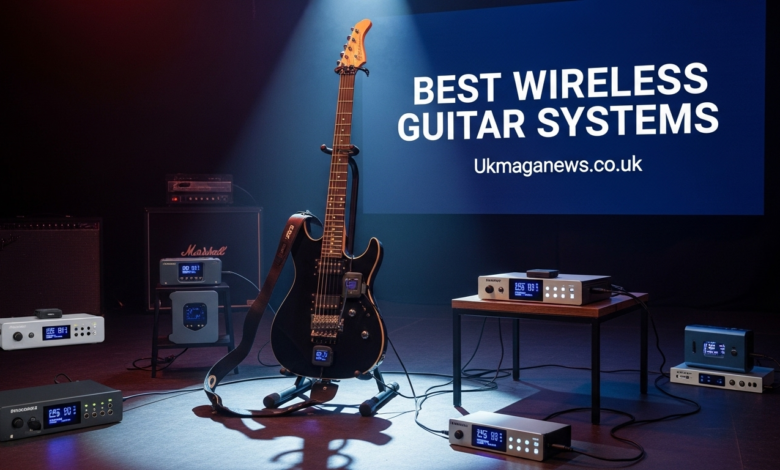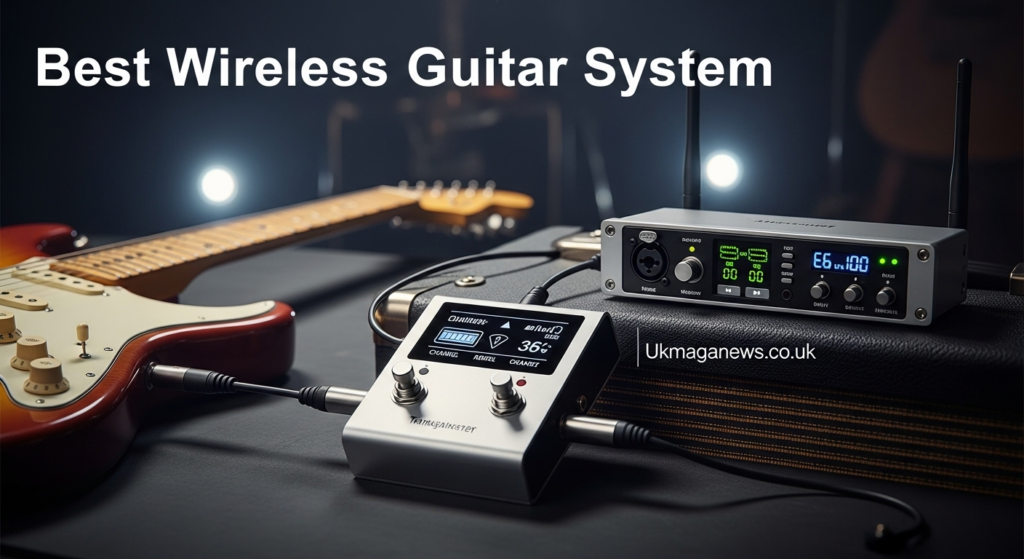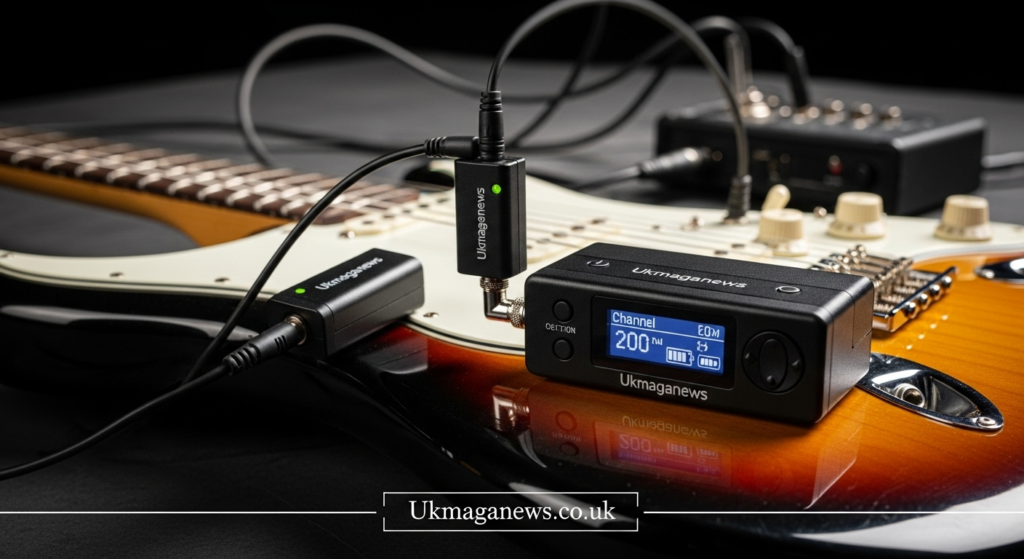Best Wireless Guitar System: Ultimate Guide to Freedom Without Sacrificing Tone

Introduction
Tripping over cables during a live performance is every guitarist’s nightmare. You’re in the zone, moving across the stage, connecting with your audience, and suddenly your guitar cable yanks you back to reality. This frustrating scenario has plagued guitarists for decades, but wireless technology has finally evolved to the point where you can perform completely cable-free without compromising your tone.
Finding the best wireless guitar system isn’t just about cutting the cord. It’s about maintaining signal quality, avoiding interference, and ensuring reliable performance when it matters most. The right system gives you freedom to move while delivering the pristine tone you’ve worked so hard to craft. Whether you’re performing on large stages, teaching students in a classroom, or simply want to practice without tripping over cables in your bedroom, wireless systems have become essential tools for modern guitarists.
In this comprehensive guide, I’ll walk you through everything you need to know about wireless guitar systems. You’ll discover the top models available today, understand the technology behind them, and learn exactly what to look for when making your purchase. By the end, you’ll know precisely which system matches your needs and budget.
Why You Need a Wireless Guitar System
The freedom of movement that wireless systems provide transforms how you perform. You can walk to the edge of the stage, interact with your audience up close, and move naturally without worrying about cable length. This physical freedom translates directly into better performances because you’re not mentally occupied with cable management.
Traditional guitar cables limit your range to about 20 feet maximum. Beyond that distance, you’re dealing with tone degradation and potential signal loss. A quality wireless system extends your range to 100 feet or more while maintaining perfect signal integrity. This expanded range opens up creative possibilities you never had before.
Wireless systems also eliminate the constant wear and tear on guitar cables. If you’ve ever dealt with crackling connections, intermittent signal drops, or cables that only work when held at specific angles, you know how frustrating cable problems can be. Going wireless means one less thing to troubleshoot during sound check.
The technology has improved dramatically in recent years. Early wireless systems were notorious for compressed tone, latency issues, and radio interference. Modern digital systems have solved these problems. The best wireless guitar system today can deliver audio quality that’s virtually indistinguishable from a high-quality cable connection.
Understanding Wireless Guitar System Technology
Wireless guitar systems work by converting your guitar’s analog signal into a radio frequency transmission. The transmitter plugs into your guitar and sends the signal to a receiver connected to your amplifier. The key is doing this conversion without degrading your tone or introducing latency that makes your playing feel sluggish.
There are two main types of wireless systems: analog and digital. Analog systems use FM radio transmission and have been around for decades. They’re simple, reliable, and generally less expensive. However, they’re more susceptible to interference and offer limited frequency options in crowded environments.
Digital wireless systems convert your audio signal into digital data before transmission. This approach provides superior sound quality, better range, and more resistance to interference. The best wireless guitar system options today are almost exclusively digital because the technology has matured to the point where latency is negligible.
Frequency bands matter more than you might think. Most wireless systems operate in either the 2.4 GHz band or the UHF spectrum. The 2.4 GHz band is crowded with WiFi, Bluetooth, and other devices, which can cause interference. UHF systems typically offer more reliable performance, especially in venues with lots of wireless activity.
Top Features to Look for in Wireless Systems
Audio quality should be your first consideration when evaluating wireless guitar systems. Look for systems with at least 24-bit audio resolution and a frequency response that covers the full range of your guitar. Anything less than 20 Hz to 20 kHz is limiting your tone before it even reaches your amp.
Battery life can make or break your experience with wireless systems. Most transmitters run on rechargeable batteries, and you need enough power to last through rehearsals and performances. The best systems offer at least 5 to 8 hours of continuous use. Some even feature hot-swappable batteries so you can change them without powering down.
Range is another critical factor. If you only play small club gigs, 100 feet might be plenty. Larger venues require systems that can reliably transmit 200 feet or more. Always consider the range specification as a line-of-sight measurement. Walls, people, and metal structures all reduce effective range.
Build quality matters because these devices take abuse. Your transmitter gets plugged and unplugged constantly, potentially bumped during performances, and tossed in gig bags. Look for metal construction, reinforced connectors, and overall solid feel. Plastic housings crack and fail at the worst possible moments.
The user interface should be intuitive enough to adjust on the fly. You don’t want to fumble through complex menus during sound check. Simple LED indicators, easy-to-access controls, and clear channel selection make your life easier. Some systems even offer smartphone apps for advanced configuration.

The Best Wireless Guitar System Options Available
Line 6 Relay G10S stands out as an excellent entry-level option that doesn’t compromise on quality. This system uses the 2.4 GHz band and delivers impressive sound quality with extremely low latency. The transmitter is compact, plugging directly into your guitar without any belt pack. You simply dock it in the receiver to charge, which is incredibly convenient.
The G10S offers about 130 feet of range and up to 8 hours of battery life. Setup is completely automatic with no frequency coordination needed. Just plug in and play. This simplicity makes it perfect for guitarists who want wireless freedom without technical hassles. The receiver doubles as a charging dock, so your transmitter is always ready when you need it.
Shure GLXD16+ represents the professional standard that many touring musicians trust. Operating in the 2.4 GHz band, it features automatic frequency management that constantly scans for the clearest channel. The system delivers 24-bit audio quality and keeps latency under 4 milliseconds, which is imperceptible even to the most sensitive players.
This system includes intelligent rechargeable battery management. The transmitter provides up to 16 hours on a single charge, and the included dual-dock charger lets you keep a spare battery ready. The receiver features both 1/4 inch and XLR outputs, making it versatile for different setups. Build quality is exceptional, as you’d expect from Shure.
Boss WL-50 offers unique features that make it one of the best wireless guitar system choices for guitarists who value simplicity. The cable tone simulation is particularly clever, mimicking the subtle capacitance of traditional cables that some players prefer. The system uses proprietary 2.4 GHz transmission with automatic channel selection.
Setup takes seconds because everything is preconfigured. The transmitter and receiver are remarkably compact, and both can be powered by standard 9V power supplies or USB. Battery life reaches about 12 hours, and the latency is incredibly low at 2.9 milliseconds. The WL-50 proves that professional wireless doesn’t require complicated setup or massive price tags.
Sennheiser XSW-D Instrument Set brings German engineering to the wireless world with exceptional reliability. This 2.4 GHz system features one-touch ease of use where transmitter and receiver link automatically. The sound quality is pristine with wide dynamic range that preserves every nuance of your playing.
Battery life hits approximately 5 hours, which is adequate for most gigs. The included charging cables make it easy to top up between sets. The system offers remarkable range for its size, maintaining solid connections up to 250 feet in optimal conditions. The compact form factor means it won’t weigh down your guitar or take up much pedal board space.
Audio-Technica System 10 operates in the rarely used 2.4 GHz band with a twist. It uses frequency diversity technology, automatically switching between frequencies to maintain the clearest possible signal. This approach virtually eliminates dropouts and interference issues that plague other wireless systems.
The System 10 delivers 24-bit audio with a frequency response from 20 Hz to 20 kHz. Latency stays under 2.4 milliseconds, making it one of the fastest wireless systems available. The transmitter uses two AA batteries and provides about 8 hours of operation. Three diversity antennas on the receiver ensure rock-solid performance even in challenging RF environments.
Budget Considerations for Wireless Systems
Entry-level wireless systems start around 150 to 200 dollars and can serve you well for practice and small venue performances. These systems typically use the 2.4 GHz band and offer basic features without advanced frequency management. They’re perfect if you’re just exploring wireless technology or have limited needs.
Mid-range systems in the 300 to 600 dollar range represent the sweet spot for most guitarists. You get professional audio quality, reliable performance, better build quality, and features like rechargeable batteries and longer range. This is where you’ll find the best wireless guitar system options that balance performance and affordability.
Professional touring systems cost 800 dollars and up, often exceeding 1,000 dollars for top-tier models. These systems justify their price with UHF transmission, exceptional range, multiple channel options, and bulletproof reliability. If you depend on your gear for your livelihood, this investment makes sense.
Consider the total cost of ownership beyond the initial purchase. Some systems use standard batteries that you’ll replace constantly. Others include rechargeable batteries that may need replacement after a few years. Factor in backup transmitters, spare batteries, and potential repair costs when budgeting.
How to Set Up Your Wireless System Properly
Start by fully charging your transmitter and ensuring your receiver has power. Most modern systems require minimal setup, but you should read the manual to understand your specific model’s features. Knowing how to access channel selection and check battery status saves time during sound checks.
Position your receiver carefully for optimal performance. Place it where it has clear line of sight to your transmitter when possible. Avoid putting it on the floor where feet might kick it or block the signal. Mount it on your amp, place it on top of your cabinet, or use a small stand to elevate it.
Check your levels before you start playing. The input level on your transmitter should be adjusted so your hottest playing doesn’t cause clipping. Many systems have LED indicators that show when your signal is too hot. Getting this right ensures clean tone without distortion introduced by the wireless system itself.
Test your range before the show starts. Walk around the venue with your guitar to verify you maintain a solid connection everywhere you plan to go. Note any dead spots where the signal weakens. This knowledge prevents surprises during your performance.
Keep spare batteries charged and accessible. Even with great battery life, you should have backups ready. Some guitarists keep a traditional cable as an emergency backup too. It takes up minimal space in your gig bag and can save your performance if something goes wrong with your wireless system.
Common Problems and How to Solve Them
Interference is the most common issue with wireless guitar systems. If you hear crackling, dropouts, or strange noises, other wireless devices are probably competing for the same frequencies. Switch channels on your system until you find a clear one. The 2.4 GHz band is particularly crowded in venues with lots of WiFi and Bluetooth devices.
Reduced range often comes from weak batteries or physical obstructions. Check your battery level first, as performance degrades as power drops. If batteries are fine, look for metal structures, concrete walls, or large crowds between your transmitter and receiver. Repositioning your receiver higher or closer might solve the problem.
Tone degradation can happen if your wireless system isn’t matched properly to your guitar and amp setup. Some systems include tone adjustments or cable simulation features. Experiment with these settings to find what sounds best with your rig. The best wireless guitar system for someone else might need different settings for your gear.
Latency issues are rare with modern digital systems, but they can occur if multiple wireless systems interfere with each other. If your playing feels delayed or disconnected, try changing channels or moving your receiver away from other wireless equipment. Latency under 5 milliseconds is generally imperceptible, so if you notice it, something is wrong.
Connection dropouts during performance are nightmares that usually stem from poor placement or interference. Make sure your transmitter’s antenna has a clear path to the receiver. Some body positions can block the signal if you’re using a belt pack transmitter. Finding the optimal placement through testing prevents these embarrassing moments.
Comparing Wireless Systems to Traditional Cables
Sound quality differences between good cables and quality wireless systems are minimal in blind tests. Modern digital wireless technology has eliminated the tone coloration and compression that plagued earlier systems. You might even prefer the consistency of wireless, as cables can develop problems that subtly degrade your tone over time.
The convenience factor heavily favors wireless systems once you’ve experienced true cable freedom. You’ll never go back to managing cables once you’ve felt what it’s like to move naturally on stage. This freedom isn’t just physical; it’s mental. You stop thinking about your cable and focus completely on your performance.
Reliability is where cables traditionally had the advantage, but the best wireless guitar system options today are incredibly dependable. A quality cable has no batteries to die and no frequencies to compete for. However, cables also wear out, develop shorts, and limit your movement. The tradeoff increasingly favors wireless as the technology improves.
Cost comparison shows cables winning on pure economics. A decent cable costs 20 to 40 dollars and lasts for years. A wireless system requires a significant upfront investment plus ongoing battery costs. However, many guitarists find the benefits worth the expense. Professional players view wireless systems as essential tools rather than luxury items.
Wireless Systems for Different Playing Situations
Studio recording presents unique considerations for wireless systems. Latency matters more in the studio where you’re monitoring through headphones and possibly recording to a click track. The best wireless guitar system for studio use minimizes latency to 3 milliseconds or less. Sound quality becomes paramount since everything gets scrutinized in recordings.
Live performance on small stages doesn’t require extensive range, but reliability is crucial. You need a system that won’t drop out when you move around, even if you’re only covering 30 or 40 feet. Interference resistance matters because small venues often pack lots of wireless systems into tight spaces. Battery life should last your entire set without worry.
Large venue performances demand maximum range and bulletproof reliability. You need professional-grade systems that can handle 200 feet or more while maintaining perfect signal quality. Multiple channel options help when several acts use wireless systems during the same show. These situations justify investing in higher-end equipment.
Worship and church settings often involve long services where battery life becomes critical. You might need 3 or 4 hours of continuous use or more. Interference can be problematic with multiple wireless microphones, instruments, and in-ear monitors competing for spectrum. Look for systems with excellent frequency management and long battery life.
Teaching environments benefit from wireless systems that let you move around the classroom freely. You don’t need extensive range, but you want reliability and ease of use. Systems that charge via docking are convenient because you can leave them charging when not in use. The ability to quickly connect and start playing helps keep lessons flowing smoothly.
Future of Wireless Guitar Technology
Digital technology continues to advance, promising even better performance in future wireless systems. Manufacturers are developing more efficient compression algorithms that preserve every detail of your tone while reducing the bandwidth needed for transmission. This efficiency improvement could lead to longer battery life and even lower latency.
Battery technology improvements will extend playing time and reduce charging frequency. Some companies are exploring wireless charging solutions where your transmitter charges simply by being near the receiver. Others are working on solar-assisted charging for outdoor performers. These innovations will make wireless systems even more convenient.
Artificial intelligence might play a role in managing frequencies and optimizing signal paths. Smart systems could automatically detect and avoid interference, adjust transmission power based on distance, and even predict when batteries need charging. The best wireless guitar system of the future might configure itself perfectly for every situation.
Integration with amp modeling and effects processors is already happening but will likely expand. Imagine your wireless system communicating with your pedalboard to switch presets based on where you are on stage. Or systems that automatically adjust your tone based on the acoustic properties of different venue areas. These smart features could revolutionize live performance.
Making Your Final Decision
Assess your actual needs honestly before buying. Do you really need 300 feet of range, or would 100 feet serve you fine? Will you use this daily or just for occasional gigs? Your playing situations should drive your decision more than feature lists. The best wireless guitar system for you matches your specific requirements.
Try systems before buying if possible. Many music stores have demo units you can test with your own guitar and amp. This hands-on experience reveals how the system sounds with your gear and whether the interface works for you. What works great for someone else might feel awkward with your setup.
Read reviews from working musicians who use these systems in real-world situations. Look for patterns in feedback about reliability, sound quality, and customer service. A few negative reviews among hundreds of positive ones might not matter, but consistent complaints about specific issues should raise red flags.
Consider future expandability if you might add more wireless systems later. Some systems let you run multiple transmitters through one receiver. Others work well alongside each other without interference. Thinking ahead can save money and hassle as your needs grow.

Conclusion
Finding the best wireless guitar system transforms your playing experience by giving you complete freedom of movement without sacrificing tone quality. Whether you choose an entry-level system like the Line 6 Relay G10S or invest in professional gear like the Shure GLXD16+, going wireless opens up creative possibilities that cables simply cannot match. The technology has evolved to the point where there’s no reason to stay tethered to your amplifier.
Your perfect wireless system depends on your specific needs, budget, and playing situations. A bedroom player has different requirements than a touring musician, and there’s a system designed for each scenario. Take time to evaluate the features that matter most to you, test options when possible, and invest in quality equipment that will serve you reliably for years to come.
The freedom to move naturally on stage changes everything about how you perform and connect with your audience. Are you ready to cut the cord and experience what you’ve been missing? Your journey to wireless freedom starts with choosing the system that’s right for you.
Frequently Asked Questions
Do wireless guitar systems affect tone quality?
Modern digital wireless guitar systems have virtually no impact on tone quality when properly set up. The best systems use 24-bit audio resolution and maintain full frequency response from 20 Hz to 20 kHz. Some players actually prefer wireless because it eliminates the subtle high-frequency loss that occurs with very long cables. Budget systems may introduce slight compression, but quality units are transparent.
How long do wireless guitar system batteries typically last?
Battery life varies significantly by model and usage. Most rechargeable systems provide 5 to 8 hours of continuous use, with some professional models reaching 12 to 16 hours. Systems using standard AA or 9V batteries typically last 6 to 10 hours. Always carry spare batteries or a backup transmitter for long gigs or multiple sets.
Can I use multiple wireless systems at the same venue?
Yes, but you need to coordinate frequencies carefully to avoid interference. Most modern digital systems can automatically find clear channels, but there are limits. Generally, you can run 4 to 6 systems in the 2.4 GHz band without issues. UHF systems often support more simultaneous channels. Always test before the show starts to ensure everyone’s system works properly.
What is the realistic range of wireless guitar systems?
Manufacturer specifications list line-of-sight range, but real-world performance is lower. A system rated for 200 feet might realistically provide 100 to 150 feet in venues with walls, people, and equipment. The 2.4 GHz systems typically offer 100 to 150 feet of usable range, while UHF systems can reach 200 to 300 feet. Always test your specific environment.
Are wireless systems reliable enough for professional use?
Absolutely. Professional touring musicians trust wireless systems daily for critical performances. The key is choosing quality equipment, maintaining it properly, and having backup plans. The best wireless guitar system models from reputable manufacturers offer reliability that matches or exceeds traditional cables. Many pros consider them essential tools rather than optional accessories.
Do I need different systems for active versus passive pickups?
Most wireless systems work with both active and passive pickups without issues. However, active pickups output hotter signals that might require gain adjustment on your transmitter. Some systems include switches or adjustments for different pickup types. Check your system’s specifications, but compatibility is rarely a problem with modern equipment.
Will WiFi and Bluetooth interfere with my wireless guitar system?
The 2.4 GHz band is crowded with WiFi, Bluetooth, and other devices, so interference is possible. Quality systems include frequency hopping and automatic channel selection to minimize problems. UHF systems avoid this issue entirely by using different frequencies. In practice, interference is manageable with good equipment, though you might need to switch channels in crowded venues.
Can I use a wireless system with pedals and effects?
Yes, wireless systems work seamlessly with pedalboards and effects. Place the receiver at the beginning of your signal chain where your guitar cable would normally plug in. Your tone and effects respond exactly as they would with a cable. Some players even put the receiver in a loop switcher for maximum flexibility.
How often do wireless systems need maintenance?
Wireless systems require minimal maintenance beyond keeping batteries charged and occasionally cleaning connectors. Rechargeable batteries typically last 2 to 3 years before capacity degrades noticeably. Keep firmware updated when manufacturers release improvements. The transmitter’s input jack sees the most wear and might need attention after heavy use.
Is there latency with wireless guitar systems?
Modern digital wireless systems have extremely low latency, typically 2 to 5 milliseconds, which is imperceptible to most players. For reference, standing 3 feet from your amp creates about 3 milliseconds of acoustic latency. Quality wireless systems introduce less delay than you’d experience naturally in most playing situations. Only the cheapest systems have noticeable latency issues today.
Also Read Ukmaganews.co.uk



